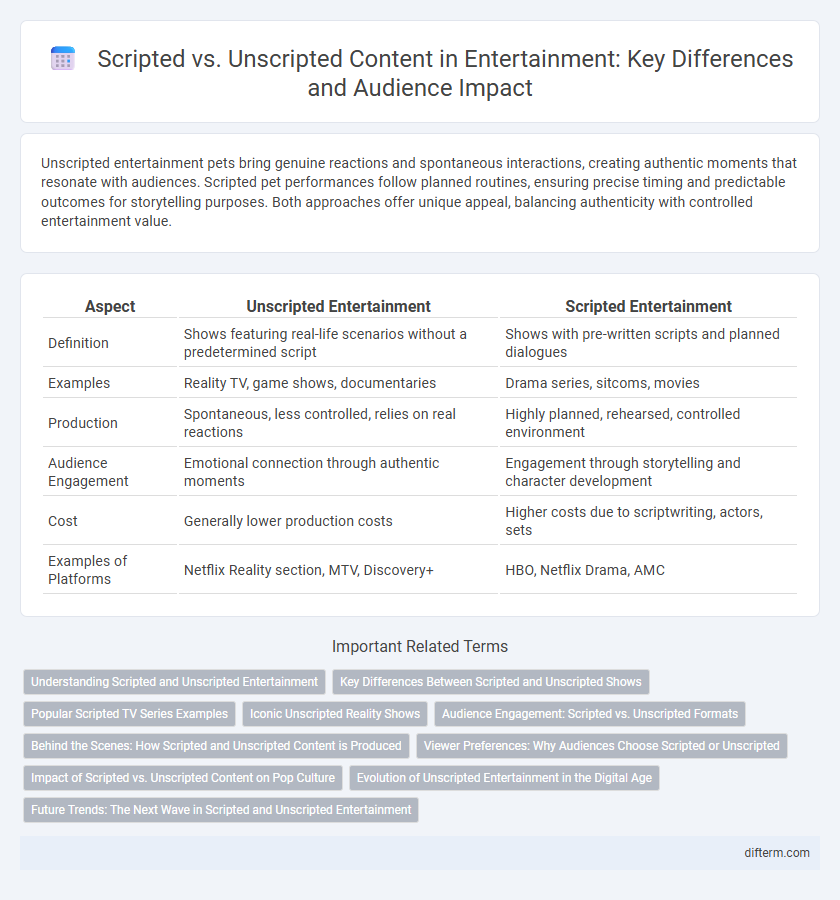Unscripted entertainment pets bring genuine reactions and spontaneous interactions, creating authentic moments that resonate with audiences. Scripted pet performances follow planned routines, ensuring precise timing and predictable outcomes for storytelling purposes. Both approaches offer unique appeal, balancing authenticity with controlled entertainment value.
Table of Comparison
| Aspect | Unscripted Entertainment | Scripted Entertainment |
|---|---|---|
| Definition | Shows featuring real-life scenarios without a predetermined script | Shows with pre-written scripts and planned dialogues |
| Examples | Reality TV, game shows, documentaries | Drama series, sitcoms, movies |
| Production | Spontaneous, less controlled, relies on real reactions | Highly planned, rehearsed, controlled environment |
| Audience Engagement | Emotional connection through authentic moments | Engagement through storytelling and character development |
| Cost | Generally lower production costs | Higher costs due to scriptwriting, actors, sets |
| Examples of Platforms | Netflix Reality section, MTV, Discovery+ | HBO, Netflix Drama, AMC |
Understanding Scripted and Unscripted Entertainment
Scripted entertainment involves pre-written dialogues and structured narratives, creating controlled story arcs and character development, commonly seen in dramas, sitcoms, and films. Unscripted entertainment relies on spontaneity and real-life interactions without a predetermined script, often featured in reality TV shows, game shows, and live broadcasts. The contrast between scripted and unscripted formats influences audience engagement, production techniques, and the authenticity of content delivery.
Key Differences Between Scripted and Unscripted Shows
Scripted shows follow a predetermined storyline with actors delivering dialogue from a written script, ensuring consistent plot development and character arcs. Unscripted shows, such as reality TV or game shows, rely on real-life scenarios and participant reactions, emphasizing spontaneity and unpredictability. Key differences include control over narrative, production style, and audience engagement, with scripted content prioritizing storytelling accuracy and unscripted content offering authentic viewer experiences.
Popular Scripted TV Series Examples
Popular scripted TV series such as "Breaking Bad," "Game of Thrones," and "Stranger Things" showcase intricate storylines and character development that distinguish them from unscripted content. These series rely heavily on carefully crafted scripts, professional actors, and detailed production design to create immersive narratives. The success of scripted shows is often measured by their ability to deliver complex plots and emotional depth that engage audiences episode after episode.
Iconic Unscripted Reality Shows
Iconic unscripted reality shows like "Survivor," "The Real World," and "Big Brother" revolutionized television by blending authentic human emotion with unpredictable scenarios, capturing audiences worldwide. These shows thrive on spontaneity and real-time reactions, distinguishing them sharply from scripted series that rely on predetermined dialogue and plotlines. Their impact is evident in how they shape viewer engagement and influence pop culture through genuine, unscripted storytelling.
Audience Engagement: Scripted vs. Unscripted Formats
Unscripted formats often drive higher audience engagement through genuine reactions and unpredictable scenarios, fostering a sense of authenticity and connection. Scripted formats provide structured storytelling with polished narratives, appealing to viewers seeking well-developed characters and plotlines. Audience preferences vary, with some gravitating towards the immersive realism of unscripted content while others prioritize the crafted creativity of scripted productions.
Behind the Scenes: How Scripted and Unscripted Content is Produced
Behind the scenes, scripted content relies on detailed scripts, professional actors, and controlled environments to ensure precise storytelling, while unscripted content thrives on real-time reactions, spontaneity, and authentic interactions often captured through multi-camera setups and extended filming periods. Production teams for scripted shows focus heavily on pre-production planning, rehearsals, and post-production editing to craft a polished final product, whereas unscripted shows demand flexible directing, adaptive crew management, and rapid content review to maintain genuine viewer engagement. Both formats utilize advanced editing software and audience analytics to optimize pacing and emotional impact, tailoring the final output to maximize entertainment value and viewer retention.
Viewer Preferences: Why Audiences Choose Scripted or Unscripted
Viewer preferences in entertainment often hinge on the predictability and creativity of scripted shows versus the authenticity and spontaneity of unscripted content. Scripted programs appeal to audiences seeking well-crafted narratives and character development, seen prominently in dramas and sitcoms. Unscripted formats such as reality TV and documentaries attract viewers who value real-life situations and unscripted reactions, providing a sense of immediacy and emotional connection.
Impact of Scripted vs. Unscripted Content on Pop Culture
Scripted content, such as TV dramas and sitcoms, shapes pop culture by creating iconic characters and catchphrases that resonate across generations, influencing fashion, language, and social trends. Unscripted content, like reality TV and live competitions, drives cultural conversations by capturing authentic, unscripted moments that reflect real-time societal dynamics and viewer experiences. The interplay between these formats continuously redefines entertainment norms and audience engagement patterns in popular culture.
Evolution of Unscripted Entertainment in the Digital Age
Unscripted entertainment has evolved dramatically in the digital age, driven by platforms like YouTube, TikTok, and Netflix that champion authentic, real-time content capturing diverse lifestyles and spontaneous moments. The rise of influencer culture and user-generated videos has shifted audience preference towards unscripted formats that offer relatability and immediacy unavailable in traditional scripted shows. Advanced analytics and AI are increasingly used to tailor unscripted content, enhancing viewer engagement through personalized recommendations and interactive storytelling.
Future Trends: The Next Wave in Scripted and Unscripted Entertainment
Advancements in AI-driven content creation are shaping the future of both scripted and unscripted entertainment, enabling hyper-personalized viewer experiences through dynamic storylines and real-time audience interaction. The rise of immersive technologies, such as augmented reality (AR) and virtual reality (VR), is transforming unscripted formats by offering interactive participation and multi-dimensional storytelling. Data analytics are increasingly guiding content development, optimizing narrative structures in scripted series while refining casting and format choices for reality and documentary genres to maximize engagement.
unscripted vs scripted Infographic

 difterm.com
difterm.com